Why Half of Americans Now Watch TV With Subtitles (A Survey)

Written by
Ernest Bio Bogore

Reviewed by
Ibrahim Litinine
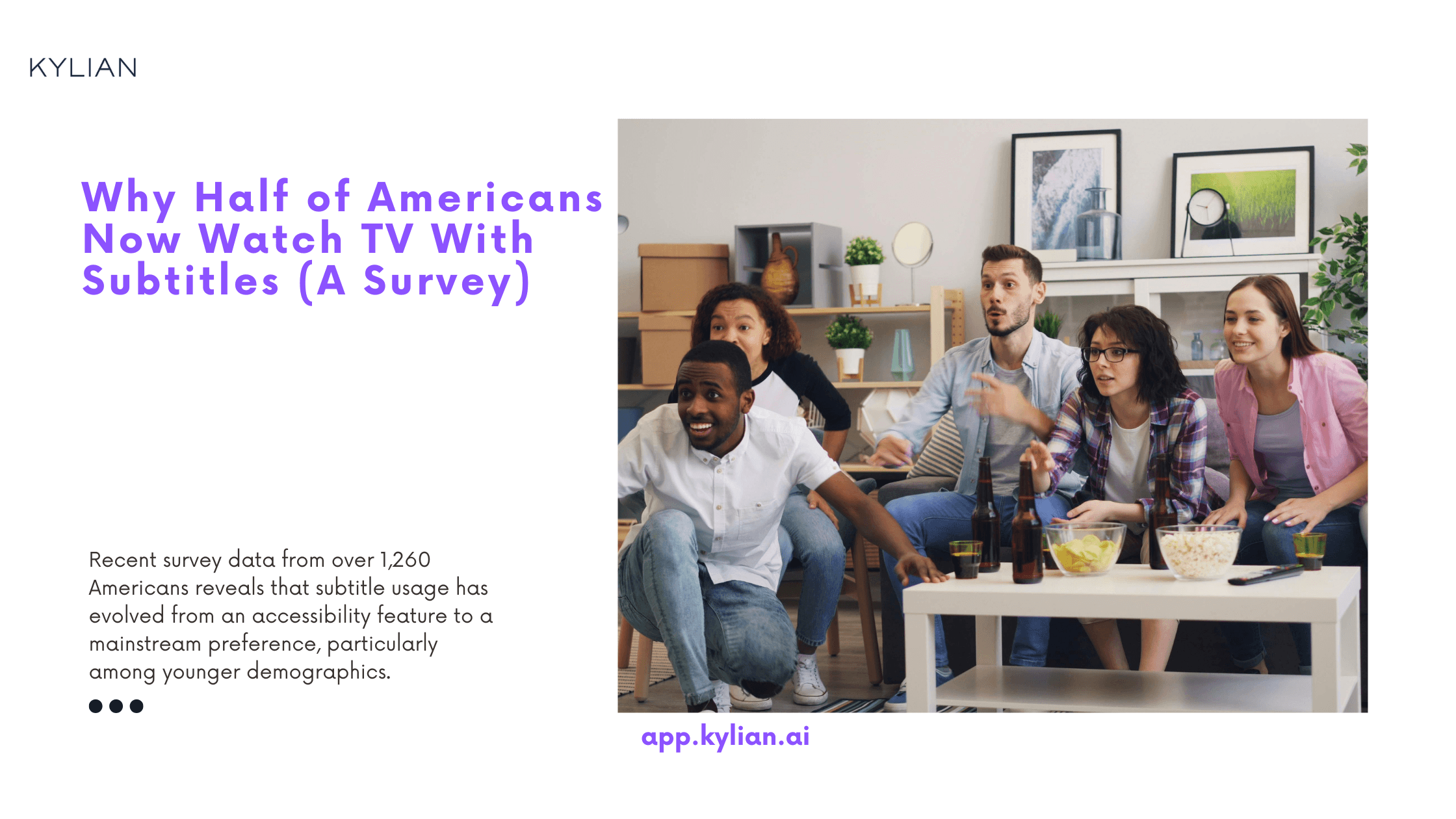
The entertainment landscape has shifted dramatically, and the numbers tell a compelling story: 50% of Americans now watch content with subtitles most of the time. This isn't just about accessibility anymore—it's about a fundamental change in how we consume media.
Recent survey data from over 1,260 Americans reveals that subtitle usage has evolved from an accessibility feature to a mainstream preference, particularly among younger demographics. The implications extend beyond viewer habits, touching on audio production quality, streaming platform design, and the very nature of modern content consumption.
The Data Behind America's Subtitle Revolution
The statistics paint a clear picture of generational divide and changing preferences. While 50% of all respondents use subtitles regularly, the breakdown by generation reveals the true scope of this shift:
- Generation Z: 70% use subtitles most of the time
- Millennials: 53% are frequent users
- Generation X: 38% use subtitles regularly
- Baby Boomers: 35% are consistent users
This data suggests we're witnessing a behavioral transformation that will only accelerate as digital natives become the dominant viewing demographic. The 20-point gap between Gen Z and Baby Boomers indicates this isn't merely a trend—it's a fundamental shift in content consumption patterns.
Why Americans Are Turning to Subtitles: The Core Drivers
Audio Quality Crisis in Modern Productions
The most significant factor driving subtitle adoption isn't hearing impairment or language barriers—it's audio quality. A staggering 72% of respondents cite muddled audio as their primary reason for subtitle use. This points to a systemic issue in modern audio production.
The data reveals specific audio-related challenges:
- 78% struggle to hear dialogue due to overwhelming background music
- 55% believe dialogue is harder to understand than in previous productions
- 61% rely on subtitles when accents prove difficult to parse
This audio crisis reflects broader changes in production values. Modern films and television shows often prioritize atmospheric soundscapes over dialogue clarity, creating an unintended accessibility barrier that subtitles help overcome.
The Multitasking Media Consumer
Contemporary viewing habits reflect our fractured attention economy. The survey reveals that 27% of Americans use subtitles to maintain focus while managing multiple distractions—screens, children, work responsibilities, and household activities.
This behavioral shift represents a fundamental change in how we engage with entertainment. Rather than passive consumption, modern viewing has become an active, multitasking experience where subtitles serve as an attention anchor.
Privacy and Social Considerations
Nearly one-third of respondents (29%) use subtitles to watch content quietly at home, avoiding disturbance to family members or roommates. This social consideration has become increasingly relevant as living spaces become more shared and flexible.
The public viewing trend amplifies this need. With 57% of Americans watching content in public spaces—rising to 74% among Gen Z—subtitles have become essential for maintaining privacy while consuming media on personal devices.
Technical Production Changes Driving Subtitle Adoption
The Darker Visual Trend
Modern productions have embraced darker visual aesthetics, with 44% of survey respondents noting that recent content uses significantly darker visuals than historical productions. This trend, exemplified by productions like "The Dark Knight" trilogy and "House of the Dragon," creates additional comprehension challenges when combined with unclear audio.
Accelerated Dialogue Patterns
The survey identifies another production trend: 35% of respondents believe actors and television personalities speak faster than in previous decades. This acceleration, driven by modern pacing expectations and compressed runtime demands, makes subtitle assistance increasingly valuable for comprehension.
Streaming Platform Optimization
The platform data reveals telling insights about subtitle implementation quality:
- Netflix: Ranked highest for subtitle quality and accessibility
- Amazon Prime: Second place for user-friendly subtitle features
- Hulu: Third in subtitle functionality
Notably, 62% of Americans use subtitles more frequently on streaming platforms than traditional television, suggesting that on-demand platforms have optimized subtitle delivery in ways that broadcast television hasn't matched.
Mobile Consumption and Public Viewing Patterns
The Rise of Public Content Consumption
Mobile device capabilities have transformed where and how Americans consume content. The survey reveals significant public viewing trends:
- 43% watch content on public transportation
- 42% consume media during work hours
- 37% watch videos while walking or driving
These consumption patterns make subtitles essential rather than optional, as audio becomes impractical or impossible in many public contexts.
Generation Z's Mobile-First Approach
Generation Z's relationship with subtitles reflects their mobile-first media consumption. With 74% of Gen Z watching content in public spaces, subtitles have become integral to their viewing experience rather than an accessibility add-on.
This demographic shift has profound implications for content producers and platform designers, who must optimize for subtitle-dependent viewing experiences.
Content Comprehension Challenges: Shows and Accents
Most Difficult Television Programming
Survey respondents identified specific content that presents comprehension challenges, revealing patterns in production styles and accent usage:
Television shows requiring subtitle assistance:
- British crime dramas with regional dialects
- Period pieces with historical language patterns
- International co-productions with diverse accents
- Rapid-dialogue comedies with overlapping speech
Accent Comprehension Patterns
The accent data reveals interesting cultural and linguistic patterns among American viewers:
- Scottish accents: 50% find most challenging
- Irish dialects: 17% report difficulty
- British regional accents: 17% struggle with comprehension
- South African English: 10% find problematic
- Australian variations: 4% report challenges
These percentages reflect both exposure levels and linguistic distance from standard American English patterns.
Language Learning and Cultural Content Access
Foreign Language Content Preferences
The rise of international content, particularly following successes like "Parasite" and "Squid Game," has influenced subtitle preferences for non-English productions:
- 74% prefer subtitles over dubbed audio for foreign language content
- 26% choose English dubbing when available
- 26% have used subtitles specifically for language learning purposes
This preference for subtitles over dubbing represents a significant shift from historical American viewing patterns, suggesting greater acceptance of subtitle-dependent content consumption.
Educational Applications
While entertainment remains the primary driver, 18% of respondents use subtitles for language learning purposes. This educational application transforms passive entertainment into active learning, demonstrating subtitle functionality beyond accessibility and convenience.
The Attention Economy: Pros and Cons of Subtitle Usage
Cognitive Benefits
Survey data reveals several positive impacts of subtitle usage on viewer comprehension and engagement:
- Plot comprehension: 74% report better story understanding
- Attention maintenance: 68% find subtitles help maintain screen focus
- Reduced rewinding: 55% rewind less frequently when using subtitles
These benefits suggest that subtitles enhance rather than detract from the viewing experience for most users.
Potential Drawbacks
However, subtitle usage isn't without complications:
- Visual distraction: 40% worry about missing visual elements
- Reading burden: 22% find subtitles more distracting than helpful
These concerns highlight the need for improved subtitle design and implementation that minimizes visual interference while maximizing comprehension benefits.
Industry Implications and Future Trends
Production Quality Standards
The subtitle adoption data suggests entertainment industry production standards may need recalibration. With audio comprehension issues driving adoption among mainstream audiences, producers might need to balance atmospheric audio design with dialogue clarity.
Platform Differentiation
Streaming platforms increasingly compete on subtitle quality and accessibility features. Advanced subtitle options—including customizable fonts, positioning, and styling—have become differentiating factors in platform selection.
Accessibility Integration
The mainstream adoption of subtitles benefits the broader accessibility ecosystem. As subtitle quality improves for general audiences, hearing-impaired viewers also benefit from enhanced caption accuracy and timing.
The Economics of Subtitle Production
Cost-Benefit Analysis for Content Creators
High-quality subtitle production requires significant investment in transcription accuracy, timing precision, and multiple language support. However, the survey data suggests this investment pays dividends in audience reach and satisfaction.
Platforms and producers who prioritize subtitle quality can capture the 50% of American viewers who prefer subtitle-enabled content, representing substantial market opportunity.
Global Content Strategy
International content distribution increasingly depends on subtitle quality. American audiences' growing acceptance of subtitled content opens markets for foreign productions while requiring domestic producers to compete on global subtitle standards.
Future Outlook: The Subtitle-First Generation
Generational Viewing Patterns
Generation Z's 70% subtitle usage rate suggests future content consumption will be subtitle-dependent by default. This shift requires fundamental changes in how content is produced, distributed, and optimized.
Technology Integration Opportunities
Emerging technologies offer enhanced subtitle experiences:
- AI-powered subtitle generation for real-time accuracy
- Personalized subtitle styling based on viewing preferences
- Interactive subtitle features enabling definition lookup and language learning
- Advanced positioning algorithms that avoid visual interference
Industry Adaptation Requirements
Content creators, streaming platforms, and device manufacturers must adapt to subtitle-first consumption patterns. This includes optimizing subtitle rendering across devices, improving accuracy standards, and developing new subtitle interaction paradigms.
Learn Any Language with Kylian AI
Private language lessons are expensive. Paying between 15 and 50 euros per lesson isn’t realistic for most people—especially when dozens of sessions are needed to see real progress.
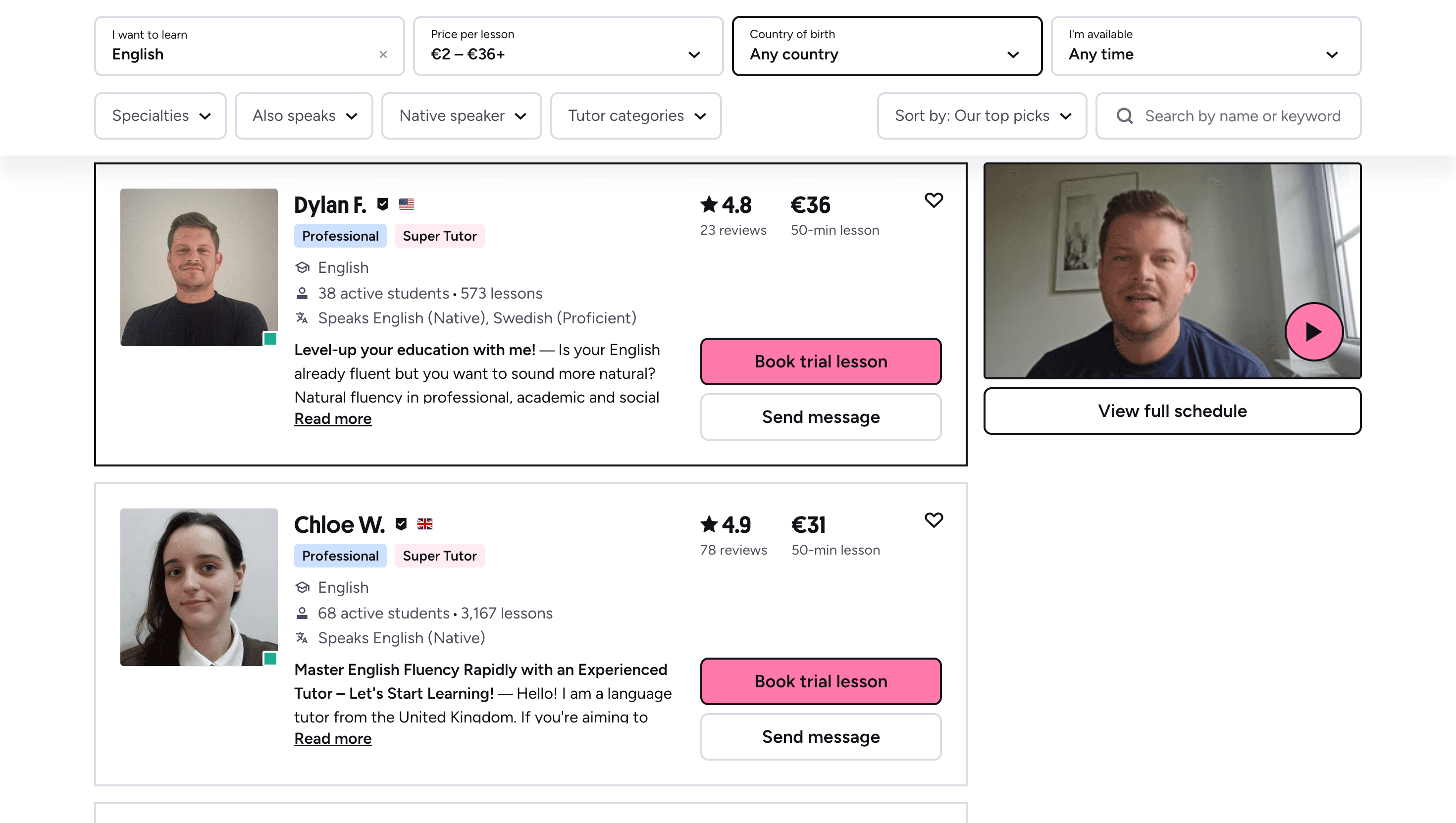
Many learners give up on language learning due to these high costs, missing out on valuable professional and personal opportunities.
That’s why we created Kylian: to make language learning accessible to everyone and help people master a foreign language without breaking the bank.
To get started, just tell Kylian which language you want to learn and what your native language is
Tired of teachers who don’t understand your specific struggles as a French speaker? Kylian’s advantage lies in its ability to teach any language using your native tongue as the foundation.
Unlike generic apps that offer the same content to everyone, Kylian explains concepts in your native language (French) and switches to the target language when necessary—perfectly adapting to your level and needs.

This personalization removes the frustration and confusion that are so common in traditional language learning.
Choose a specific topic you want to learn
Frustrated by language lessons that never cover exactly what you need? Kylian can teach you any aspect of a language—from pronunciation to advanced grammar—by focusing on your specific goals.
Avoid vague requests like “How can I improve my accent?” and be precise: “How do I pronounce the R like a native English speaker?” or “How do I conjugate the verb ‘to be’ in the present tense?”
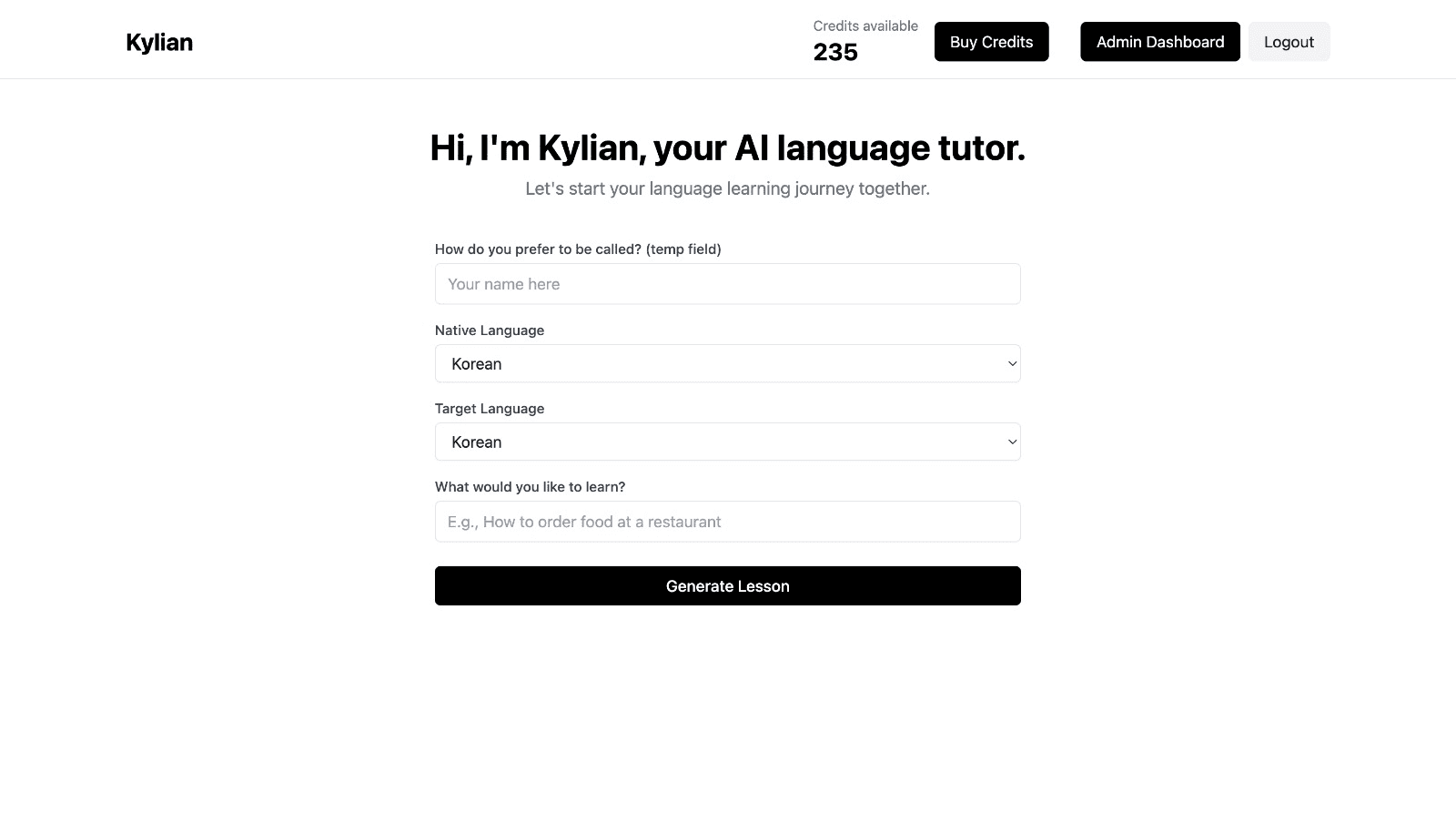
With Kylian, you’ll never again pay for irrelevant content or feel embarrassed asking “too basic” questions to a teacher. Your learning plan is entirely personalized.
Once you’ve chosen your topic, just hit the “Generate a Lesson” button, and within seconds, you’ll get a lesson designed exclusively for you.
Join the room to begin your lesson
The session feels like a one-on-one language class with a human tutor—but without the high price or time constraints.
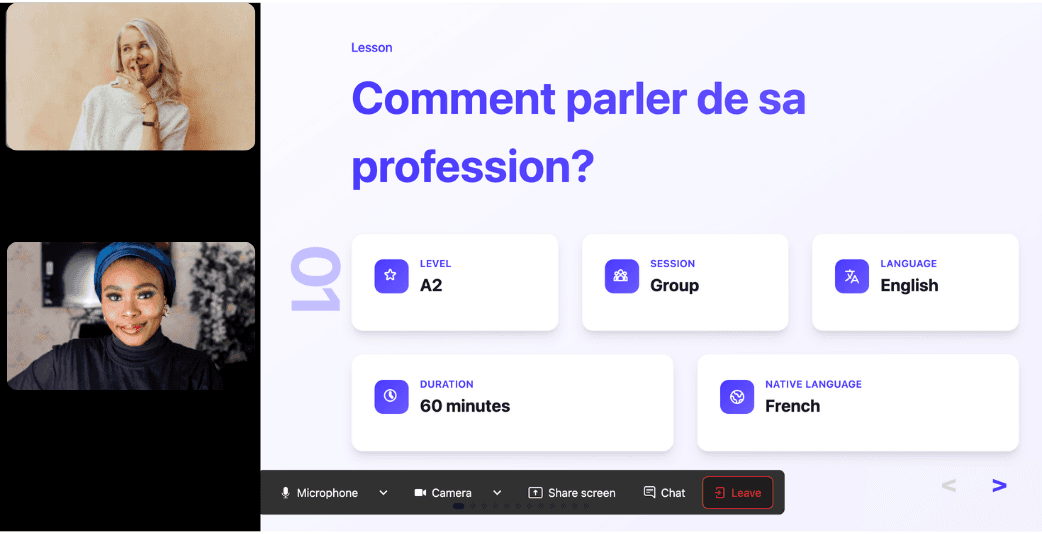
In a 25-minute lesson, Kylian teaches exactly what you need to know about your chosen topic: the nuances that textbooks never explain, key cultural differences between French and your target language, grammar rules, and much more.
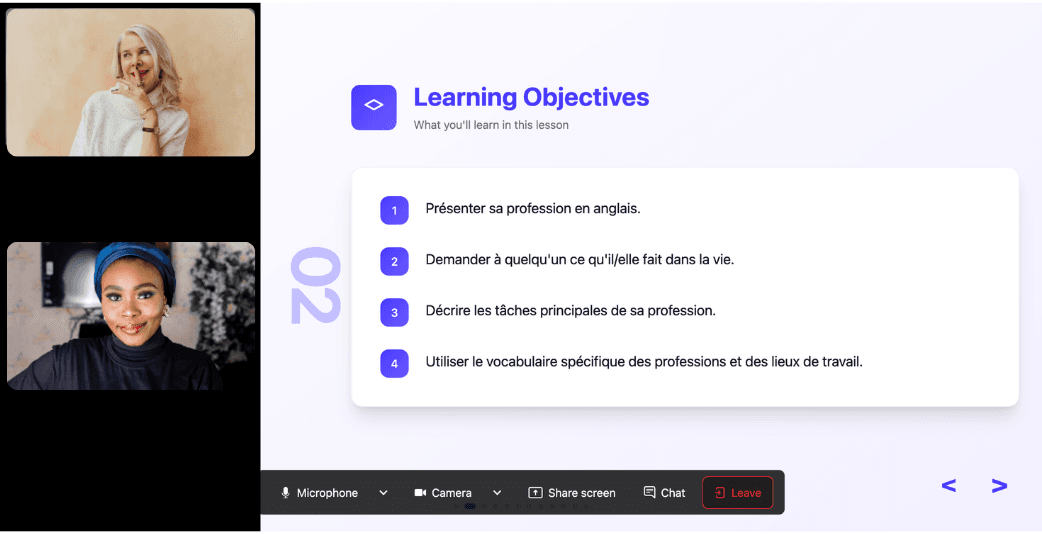
Ever felt frustrated trying to keep up with a native-speaking teacher, or embarrassed to ask for something to be repeated? With Kylian, that problem disappears. It switches intelligently between French and the target language depending on your level, helping you understand every concept at your own pace.

During the lesson, Kylian uses role-plays, real-life examples, and adapts to your learning style. Didn’t understand something? No problem—you can pause Kylian anytime to ask for clarification, without fear of being judged.
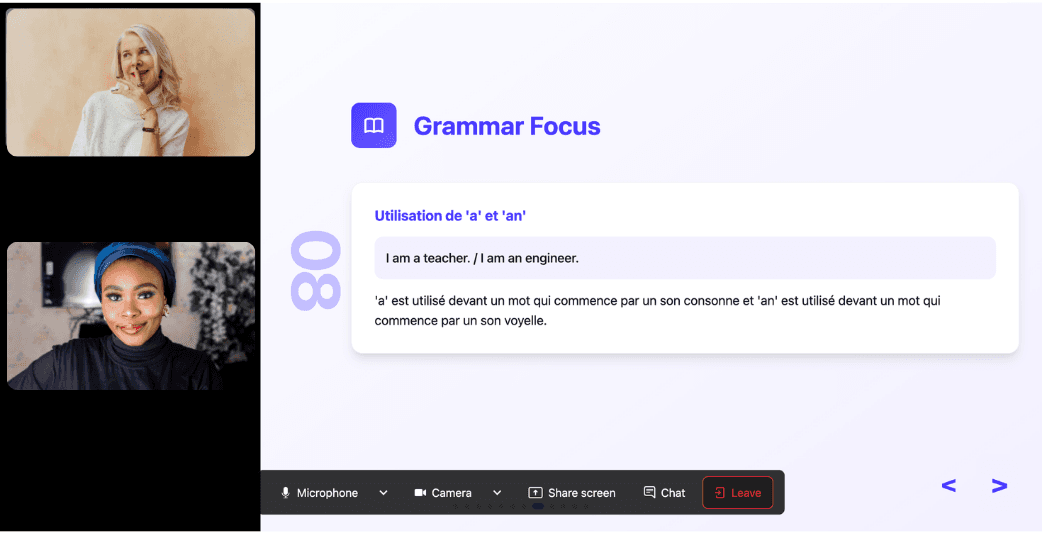
Ask all the questions you want, repeat sections if needed, and customize your learning experience in ways traditional teachers and generic apps simply can’t match.

With 24/7 access at a fraction of the cost of private lessons, Kylian removes all the barriers that have kept you from mastering the language you’ve always wanted to learn.
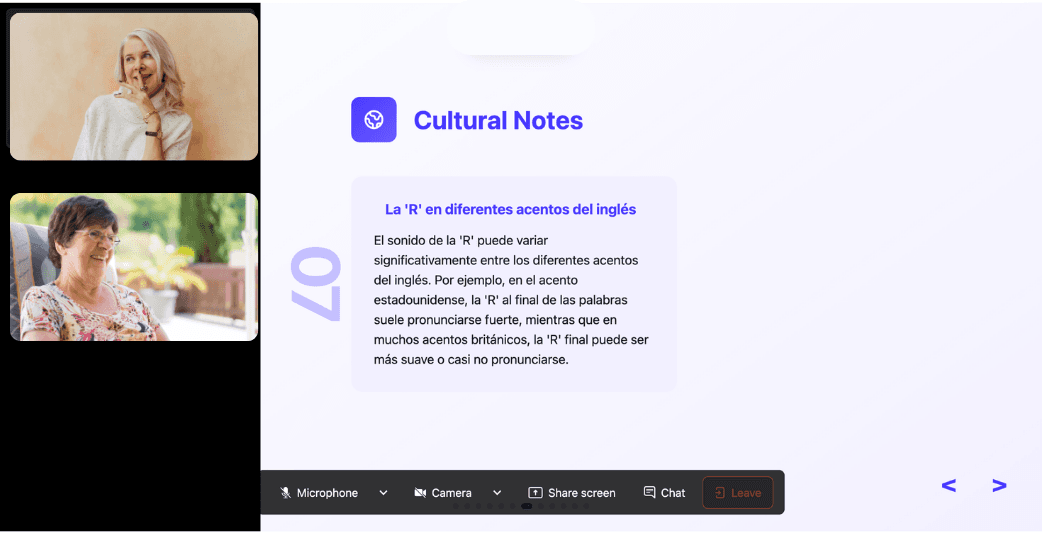
Similar Content You Might Want To Read

English Language Levels: A Complete Guide to level up
Ever caught yourself saying "I'm basically fluent in English" and immediately questioning what that actually means? The ambiguity of such statements highlights why understanding standardized language proficiency frameworks is crucial for learners and educators alike. The Common European Framework of Reference for Languages (CEFR) offers clarity through its internationally recognized scale ranging from A1 (beginners) to C2 (mastery). This framework provides concrete benchmarks for measuring language capability across speaking, listening, reading, and writing skills.

Japanese Language Levels: Your Complete Mastery Guide
Learning Japanese demands strategic commitment. Understanding the established Japanese language proficiency levels provides clarity for your learning journey and helps you measure tangible progress against standardized benchmarks.

German Language Levels: A Comprehensive Guide from A1 to C2
Understanding German proficiency levels gives language learners clarity about their progress, helps establish concrete goals, and provides tangible benchmarks that employers and educational institutions recognize. This comprehensive guide explains the six CEFR levels for German, offers practical examples, and clarifies what level you'll need to achieve your specific goals.

English Tests Guide: Complete 2025 Overview
English proficiency certification has evolved from a simple academic requirement to a critical career accelerator. The data tells a compelling story: global mobility increased by 47% post-pandemic, with English test scores directly correlating to salary premiums of 15-30% across non-English speaking countries. Yet most test-takers approach these assessments blindly, choosing tests based on familiarity rather than strategic alignment with their goals. This matters now because the landscape has fundamentally shifted. Traditional tests like TOEFL and IELTS no longer monopolize the market. Digital-first alternatives have gained institutional acceptance, while specialized tests for healthcare professionals and Canadian immigration have carved out significant niches. The choice you make today determines not just where you can study or work, but how efficiently you can prove your English competency in an increasingly competitive global market. The strategic imperative is clear: understanding which test aligns with your specific objectives, timeline, and budget constraints directly impacts your return on investment in English certification.

19 Best Websites to Learn French Online in 2025
Learning French opens doors to a rich cultural heritage and creates opportunities in an increasingly connected global landscape. With the proliferation of online language resources, finding the right platform that aligns with your learning style, goals, and budget has never been more accessible. This curated selection of the 19 most effective French learning websites delivers options for every type of learner—from those seeking personalized instruction to self-directed students looking for flexible alternatives to traditional classroom settings.

How to Learn Italian: Your Guide from Basics to Fluency
Italian beckons language enthusiasts with its melodic cadence and rich cultural heritage. The allure of mastering phrases like bellissima, tesoro, and dolcezza draws many to begin this linguistic journey. But beyond the romantic appeal lies a practical question: what does it take to achieve true fluency? This comprehensive guide breaks down the process into actionable steps, providing clarity for anyone looking to master the language of Dante and Da Vinci.